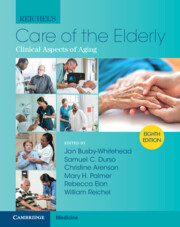Book contents
- Reichel’s Care of the Elderly
- Reichel’s Care of the Elderly
- Copyright page
- In Memoriam
- Contents
- Contributors
- Section I General Approach to the Care of the Elderly
- Section II Geriatric Syndromes
- Section III Care of the Elderly by Organ System
- Chapter 13 Diagnosis and Management of Heart Disease
- Chapter 14 Hypertension
- Chapter 15 Peripheral Artery Disease
- Chapter 16 Neurologic Problems
- Chapter 17 Prevention, Diagnosis, and Management of Stroke
- Chapter 18 Movement Disorders
- Chapter 19 Sleep Disorders
- Chapter 20 Clinical Geropsychiatry
- Chapter 21 Substance Use Disorder
- Chapter 22 Pulmonary Issues
- Chapter 23 Gastrointestinal Disorders
- Chapter 24 Serious Infections
- Chapter 25 Human Immunodeficiency Virus
- Chapter 26 Kidney Disease
- Chapter 27 Urological Conditions
- Chapter 28 Urinary Incontinence
- Chapter 29 Fecal Incontinence
- Chapter 30 Gynecologic Issues
- Chapter 31 Endocrine Disorders
- Chapter 32 Diabetes Mellitus
- Chapter 33 Lipid Management
- Chapter 34 Osteoporosis and Other Metabolic Bone Disorders
- Chapter 35 Common Rheumatologic Disease
- Chapter 36 Geriatric Emergency Medicine
- Chapter 37 Musculoskeletal Injuries
- Chapter 38 Dermatologic Conditions
- Chapter 39 Pressure Injuries
- Chapter 40 Anemia and Other Hematological Problems
- Chapter 41 Cancer
- Chapter 42 Ocular Disorders
- Chapter 43 Geriatric Otolaryngology
- Chapter 44 Oral Health
- Chapter 45 Foot Health
- Section IV Principles of Care for the Elderly
- Index
- Plate Section (PDF Only)
- References
Chapter 45 - Foot Health
from Section III - Care of the Elderly by Organ System
Published online by Cambridge University Press: 30 June 2022
- Reichel’s Care of the Elderly
- Reichel’s Care of the Elderly
- Copyright page
- In Memoriam
- Contents
- Contributors
- Section I General Approach to the Care of the Elderly
- Section II Geriatric Syndromes
- Section III Care of the Elderly by Organ System
- Chapter 13 Diagnosis and Management of Heart Disease
- Chapter 14 Hypertension
- Chapter 15 Peripheral Artery Disease
- Chapter 16 Neurologic Problems
- Chapter 17 Prevention, Diagnosis, and Management of Stroke
- Chapter 18 Movement Disorders
- Chapter 19 Sleep Disorders
- Chapter 20 Clinical Geropsychiatry
- Chapter 21 Substance Use Disorder
- Chapter 22 Pulmonary Issues
- Chapter 23 Gastrointestinal Disorders
- Chapter 24 Serious Infections
- Chapter 25 Human Immunodeficiency Virus
- Chapter 26 Kidney Disease
- Chapter 27 Urological Conditions
- Chapter 28 Urinary Incontinence
- Chapter 29 Fecal Incontinence
- Chapter 30 Gynecologic Issues
- Chapter 31 Endocrine Disorders
- Chapter 32 Diabetes Mellitus
- Chapter 33 Lipid Management
- Chapter 34 Osteoporosis and Other Metabolic Bone Disorders
- Chapter 35 Common Rheumatologic Disease
- Chapter 36 Geriatric Emergency Medicine
- Chapter 37 Musculoskeletal Injuries
- Chapter 38 Dermatologic Conditions
- Chapter 39 Pressure Injuries
- Chapter 40 Anemia and Other Hematological Problems
- Chapter 41 Cancer
- Chapter 42 Ocular Disorders
- Chapter 43 Geriatric Otolaryngology
- Chapter 44 Oral Health
- Chapter 45 Foot Health
- Section IV Principles of Care for the Elderly
- Index
- Plate Section (PDF Only)
- References
Summary
For older adults, foot problems can significantly affect mobility, function, and quality of life. Because the foot can impact overall function, the podiatric exam for either preventive or problem-related issues is an important part of geriatric care. The foot exam begins with the shoes and then includes a dermatologic, musculoskeletal, vascular, neurologic, and functional assessment. Common skin and nail conditions include hyperkeratotic lesions, ulcerations, tinea pedis, and onychomycosis. Forefoot conditions include hallux valgus (bunion), hallux limitus, hallux rigitus, digiti flexus (hammertoe), sesamoiditis, fractures, and Mortons’ neuroma (intermetatarsal neuroma). Midfoot conditions include pes planus and posterior tibial tendon dysfunction. Common heel conditions include plantar fasciitis, heel pad syndrome, Achilles tendinitis, and tarsal tunnel syndrome. Systemic disease such as diabetes and gout can also affect the foot. Treatment modalities for foot conditions can include topical, injected, or oral medications, pads or orthotics, and surgical correction. Health-care practitioners are encouraged to examine the feet of their older patients and provide education about foot care and footwear.
- Type
- Chapter
- Information
- Reichel's Care of the ElderlyClinical Aspects of Aging, pp. 558 - 568Publisher: Cambridge University PressPrint publication year: 2022

